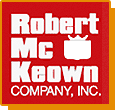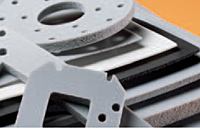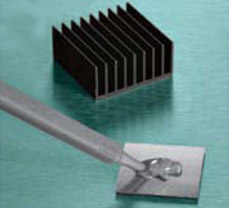In addition to a UL94V-0 listing in thicknesses down to 1/16", it withstands a 2100 °F flame for more than 10 minutes without burning through in thicknesses down to 3/8".
The material, which has a nominal density of 12 pounds per cubic foot, generates very little white smoke.
Non-corrosive for use with metals and in hostile environments, it has low compression set. Among its applications are fireblocks, thermal barriers, noise and vibration dampeners, insulation and high-performance gaskets or seals.
For the aviation, automotive and mass transit industries, it offers a high degree of design flexibility. Lightweight and easy to process, it can be laminated to seat cover fabrics and carpeting as a backing for added flame resistance in passenger compartment furnishings.
The material has similar uses in institutional and residential furnishings, marine and lighting applications. It offers properties valuable in flame retardant backings for floor,wall and furniture coverings; fire-wall and thermal barriers or insulation, padding and gasketing for commercial and private marine vehicles; or gasketing and sealing in high- intensity light fixtures and electronic components in medical, computer and business equipment.
Colored gray, it is supplied in 18" and 36" wide roll stock. Thicknesses are shown in the table below. It is available plain or, on special order, laminated to any of a wide range of substrates.
Because of the unique nature of COHRlastic foam, SGPPL CHR has undertaken a rigorous testing program which is performed at outside independent laboratories.
The tests document the flame resistant properties and low levels of toxicity and smoke generation as well as mechanical and electrical properties. Details are on file at SGPPL CHR.
Tests, claims, representations and descriptions regarding flamability are based on standard laboratory tests and, as such, may not be reliable for determining, evaluating, predicting or describing the flammability or burning characteristics under actual fire conditions, whether used alone or in combination with other products. Accordingly, each potential user should make an individual determination whether the flammability or burning characteristics of the product are suitable for the purpose intended by the user.
CHR provides certification to the specifications listed when requested with order. All properties are typical values and should not be used for writing specifications. Please consult plant concerning updated specifications. Government and military specifications are being revised at the time of this catalog printing.
Item # |
Thermal Conductivity |
Width |
Color |
Compression Deflection |
Surface Description |
Tensile Strength |
|---|---|---|---|---|---|---|
| F-12-36 F-12-36/Asset/a1184.jpg | Thermal Conductivity N/A 0.42 BTU in/h·ft2 ºF (K factor) | Width N/A 36 in | Color N/A Gray | Compression Deflection N/A 3 psi | Surface Description N/A Textured on one side | Tensile Strength N/A 25 psi |
| F-12-18 F-12-18/Asset/a1184.jpg | Thermal Conductivity N/A 0.42 BTU in/h·ft2 ºF (K factor) | Width N/A 18 in | Color N/A Gray | Compression Deflection N/A 3 psi | Surface Description N/A Textured on one side | Tensile Strength N/A 25 psi |
Robert McKeown offers a variety of adhesive and sealant products for a wide range of commercial and industrial applications. Our silicone epoxy adhesives and sealants, in particular, are ideal for applications such as:
FEATURES AND USES OF ELECTRONICS SEALANTS AND ADHESIVES
Providing ultimate reliability and longevity, our electronics adhesives and sealants can be used to form bonds to many different surfaces and substrates, including:
- Ceramics
- Metals
- Glass
- Filled plastics
These specialized solutions eliminate the need for mechanical fastening and clamping while allowing for optimal ease of processing. Reliable and efficient in temperatures ranging from -45 °C to 200 °C, our electronics adhesives and sealants provide excellent dielectric insulation.
Most silicone formulations are solventless, eliminating the need for special storage, ventilation, or handling. And because many of our electronics adhesives and solvents are reworkable, they offer great flexibility and allow for easier module repair.
Electronics adhesives and sealants are frequently used in: automotive, communications, industrial, and energy industries, as well as consumer devices.
Extremely versatile, these adhesives can be used for:
- Sealing lids and housing grooves
- Cushioning or stabilizing fragile components
- Affixing components such as capacitors and coils to circuit boards
- Adhering module lids and baseplates
- Gasketing
SILICONE ADHESIVES
One of the most popular types of electronics adhesives, silicone adhesives provide excellent flexibility and high heat resistance, making them ideal for electrical, automotive, aerospace, and construction industries. There are several varieties of silicone adhesives available, including:
- Two-component systems that require a curing agent
- One-component systems that cure through air moisture
- UV or EB radiation curing adhesives
- Pressure-sensitive versions that adhere to surfaces with little pressure
RTV sealants (room-temperature vulcanizing) begin to cure as soon as they’re exposed to moisture in the air, so they must be used quickly. Pressure-sensitive sealants offer a permanent tackiness. UV- or radiation-cured sealants, on the other hand, require UV light to cure, while thermoset silicone sealants require heat to cure. Although not as strong as other sealants or adhesives, electrical silicone sealants remain flexible even when fully dried or cured. Various types of silicone sealants serve as ideal solutions for high-heat applications like engine gaskets.
In electronics fabrication, silicone adhesive sealants are often used for fixing parts on circuit boards, LCD module assembly, general sealing, and component protection. Specific formulations differ depending on intended use and can be customized to allow for enhanced thermal conductivity, superior protection of metal electrodes, and faster cure times. These sealants are available in chemical-, heat-, mildew-, and oil-resistant formulations to meet a wide range of application needs.
Industrial silicone epoxy is used for:
- General-purpose fixture sealing of tubs
- Windows, ductwork
- Gaskets
- General-purpose bonding
- Sealing
THERMAL SEALANTS
High temperatures often present problems for conventional adhesive materials and can affect printed circuit boards and assemblies. At Robert McKeown, we offer the highest-level special adhesive grades of thermal sealants, which allow for enhanced thermal conductivity. Both low-viscosity liquids and non-slump formations are available in two-cure chemistries.
We also offer one-part moisture-cure grades, which use room-temperature processing to cut back on equipment needs. After cure, the materials form strong but flexible bonds, which protect from mechanical stress and vibration. Both one- and two-part heat-cure solutions accelerate processing and support high throughput production.
Heat resistant silicone adhesives are extremely versatile materials and dispense easily at room temperature, but can also cure quickly at any thickness level at temperatures as low as 90°C. Efficacy and functionality are improved when higher temperatures accelerate cure times.
CHEMICAL RESISTANT ADHESIVES
Chemical resistant silicone adhesives are commonly used in:
- Chemical processing plants
- Chemical piping and tanks
- Medical devices
These adhesives can reliably protect against a wide range of chemicals and harsh materials, including acid, alcohol, and fuel. Depending on specific application requirements, they can also provide resistance against solvents, bases, sterilization, and water.
EPOXY BASED ADHESIVES
Epoxy based adhesives are created by mixing a resin and a hardener. Curing is initiated when the resin is mixed with a certain catalyst. The covalent bonds resulting from this combination determine the rigidity and strength of the epoxy sealant.
Epoxy adhesives can reliably adhere to a variety of materials and are ideal for applications demanding chemical resistance, high strength, and low stress. Thermally conductive, microelectronic-grade, general-purpose, high-temperature and chemical resistant epoxy adhesives are available as both one- and two-part solutions. Epoxy adhesive and sealants allow for room temperature, thermal, or UV-curing capabilities.




